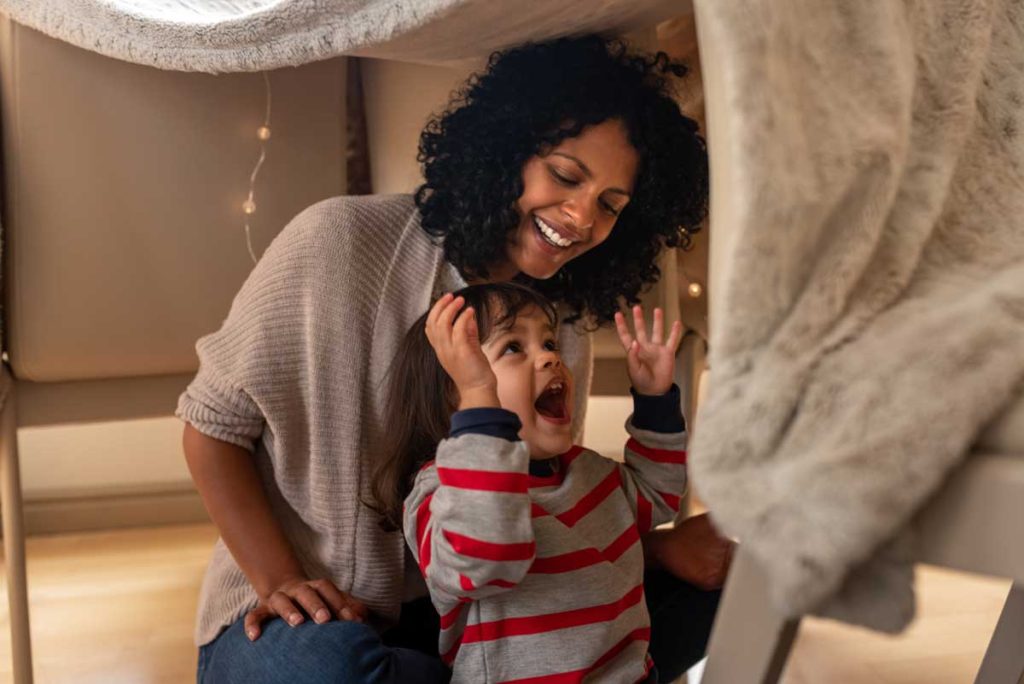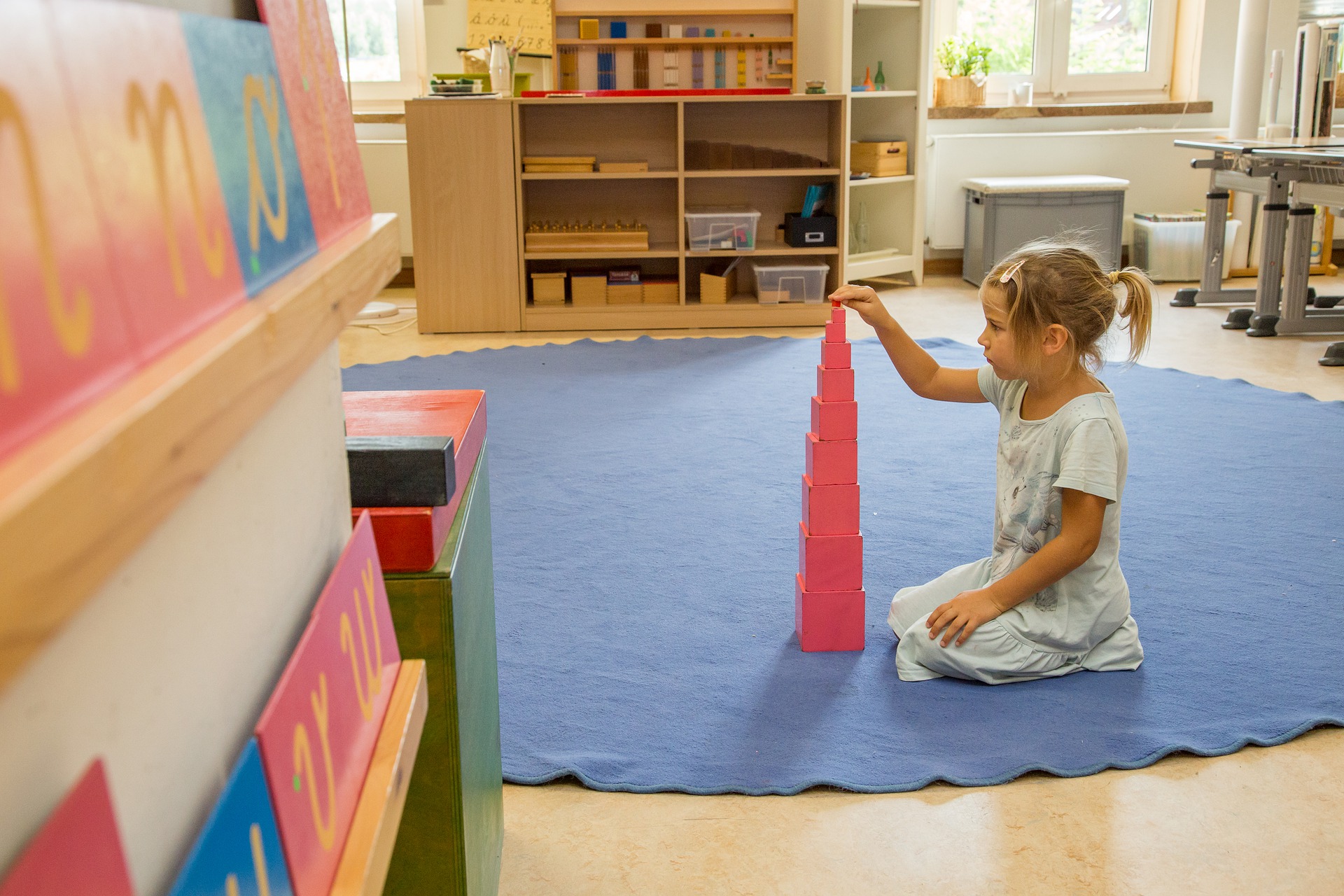The Montessori Principle of Play
The Montessori principle of play taught me to value my child’s playtime.
My youngest daughter has claimed a corner of our living room as her own. Not in words, exactly, but in action. Day after day, she barricades herself into this corner with a quick rearrangement of furniture. She expertly drapes a roof of blankets to create a fort. Then, she moves in and sets about her work.
Today, for example, my little one is there preparing a “fancy dinner party.” She hand-wrote invitations to her sisters with pen and paper. She stuffed them into envelopes and added stickers in the corners for stamps. She placed them in a mailbox that she created from a tissue box. Then, she prepared. With a real dust rag, she dusted and tidied her shelves. With a child-safe knife, she carefully sliced real bananas and cheese sticks and arranged them on plates. After pouring small glasses of water, she awaited her guests.

Play Is Purposeful
The Montessori principle of play can change how you view playtime, too.
For starters, in Montessori, play is the work of the child. In other words, play isn’t a time-filler for those pesky moments of free time between breakfast and gymnastics class. It isn’t for busying your child while you tackle the laundry and dishes in peace.
Rather, for a child, play is the day’s work. Children decode their world through play. Through play, they make discoveries: a blanket draped this way makes a sturdy fort roof, but stretched that way, it flops to the floor. They master motor skills: grip the knife this way to slice perfect bites of banana. Place your fingers here and here to fold your paper into an invitation.
Adults: Guardians of Play
So, what’s our role in this? In Montessori, adults are aptly considered “guides” rather than “instructors.” Personally, I also like to dreamily imagine ourselves as “Guardians of Play.” I think this term lends a suitably magical air to our role as Montessori-inspired parents.
It’s our job to prepare the environment, provide materials, and safeguard playtime. We are tasked with protecting and respecting our children’s play. Age-old wisdom warns new parents, “Never wake a sleeping baby.” I like to imagine Dr. Maria Montessori similarly whispering, “Shhh… Never interrupt a playing child.”
The Montessori principle of play urges adults to provide — and protect — hours of undisturbed play.
Adults: Guides in Montessori Play
With that in mind, the adults’ role is guide, not director, when it comes to the Montessori principle of play. We are advisors, not dictators. Aides, not lecturers. Adults are to help only when our help is solicited. And we help by modeling for our children, not doing for our children.
In Montessori play, we adults follow the child: first, our children show us their interests, their projects, the skills they’re working on. Then, we open the door, step aside, and let them explore.
Once, when my youngest was around 18 months old, she returned home from her well-check visit with a new fascination for eyes, ears, nose, mouth, and doctors’ tools. I knew because she showed me. She took out her doctor kit, shoved the toy otoscope into my eyes, then my ears, then my nose, then my mouth, each time saying “aaaaah” forcefully until I opened wide, stuck out my tongue, and repeated “aaaaah”. She repeated this humorous series of actions again, and again, and again.
In this way, my little one showed me that it was time to open a new door. I brought out her dolly, a stethoscope, a thermometer, Band-Aids, and a child-safe mirror — tools to support her learning. We read board books with real pictures of labeled body parts and doctors’ offices. I opened “the door” and stepped aside. The rest was her job.
First, she gave her baby doll a checkup. Then, she tried to wrap her baby in a blanket. When the baby slipped out of the blanket onto the floor, she furrowed her little brow, concentrated harder, and tried again. Finally, she got her baby sufficiently wrapped, proudly smiled up at me, and patted her swaddled (upside down) baby doll on its back.
Montessori Principle of Play(things)
What about playthings? The Montessori principle of play can also change your view of “good” toys.
 In Montessori philosophy, toys are not there to occupy your child’s time. To light up and scream “Square!” at your toddler when she touches a shape. To “entertain” or “busy” your child. Good toys spur growth, discovery, and development.
In Montessori philosophy, toys are not there to occupy your child’s time. To light up and scream “Square!” at your toddler when she touches a shape. To “entertain” or “busy” your child. Good toys spur growth, discovery, and development.
Dr. Montessori knew that children are naturally driven and goal-oriented. They desire to experiment, try, master. Montessori at home toys pique your child’s interest and dare them to try. Try to fit the piece into the puzzle. Feel this rough, gritty texture. Touch that silky, smooth one. Smell this sweet, citrus scent. Experiment with blending this yellow water with that blue water. Explore the feel of damp soil. Try sweeping the crumbs into the dustpan. Hear the sound of this shiny bell.
Play Real Life
The Montessori principle of play can change your view of playing “house,” playing “gardener,” and playing “school.” It can change how you view playing real life.
Dr. Montessori noticed that children love to play “real life” and that they prefer to use real tools when possible. So, in Montessori play, children “play” — or work — with practical life activities and child-sized versions of real things.
What’s more fun than playing house in a plastic house with a plastic kitchen, plastic dishes, and plastic foods? Playing house with a miniature broom that really sweeps. Scrubbing real dishes with a real sponge in a large bowl of warm, sudsy water. Preparing real cheese and crackers.
What’s even better than pouring magical air onto plastic flowers with a toy watering can? Using a real, child-sized watering can, sprinkling real water — and real love — onto a real flower. Smelling its sweet scent. Feeling its smooth petals. Watching it thrive and cheering it on.
A Prepared Playroom
Finally, the Montessori principle of play can help you create a more effective playroom.
When you’ve seen your little one’s priceless, satisfied smile — the one that beams with accomplishment — it will hit you: some toys are worth the real estate in your playroom. And many are not.
The Montessori principle of play calls for a carefully prepared environment. A place for everything, and everything in its place. Simple, uncluttered space that allows each beautiful, educational toy to silently call to your child, “try me!”
You’ll know you’ve got it when your little one no longer flits from toy to toy like a ping pong ball. When she forgets you’re in the room because she’s that engrossed in discovery.
Don’t worry — when she reaches that “Ah-ha!” moment, that “I did it!” satisfaction, she’ll remember you. And that proud smile will be all the proof you’ll need that Montessori is for you.
Brandi Faith is a freelance writer who holds a Master of Education degree. She earned her Bachelor of Arts degree from Northwestern University in Psychology and Spanish. Brandi passionately applies Montessori principles to her parenting and teaching at home. She loves the way Montessori philosophy encourages children to take charge of their learning and pursue their interests. Her favorite thing about Montessori is watching her kids’ eyes light up with joy and interest as they explore and experiment, and seeing their smiles light the room when they master a new skill.





0 Comments